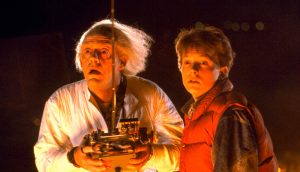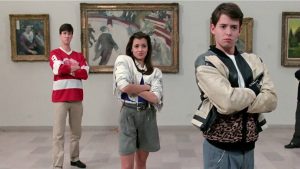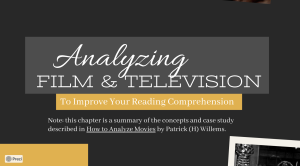24 The Basic Method
Learning Objectives
-
Explore film as a medium for meaningful conversation and an expression of human empathy.
-
Use metacognitive reading strategies before, during and after reading fiction, non-fiction and graphics.
Attribution Note: The central ideas of this unit are derived from How to Analyze Movies by Patrick (H) Willems and Moving Pictures by Russell Sharman.
Chapter & Discussion
This chapter includes a presentation that can be navigated in a classroom setting or independently. You can access the presentation via the link below.
Work through the different sections of the chapter and discuss ideas and topics as they arise. If you’re working independently, take notes instead. Notes and active discussion will be helpful in navigating this week’s assignments.
We Write Because We Have Something to Say
Just like novels, film and television are media for communicating our ideas. These include our messages, morals, and worldviews, as well as our personalities.
Film and television have different methods of communicating ideas, but their overall goals are the same.
If you practice analyzing what you watch, you can improve your reading fluency and comprehension.
Analyzing Film and Television can help you:
- Learn about the structure of stories
- Learn the vocabulary of literary discussion
- Respond emotionally and academically to your reading
- Find the main idea

The Basic Method
We naturally analyze stories when we experience them. The goal of having a basic method is to make sure we can have conversations about them using the same language.
Luckily, the basic method of film criticism is simple. It has two steps:
- Describe what you see
- Ask “Why?”
To expand on this, we can try it like this:
1. Describe what you see. This could be a scene, a setting, a costume, an actor, or even a single shot.
Give details. See how much you can say about what you noticed.
2. Ask “Why?” Remember, everything in this movie is a choice. Try to get at why the writers/directors made these choices.
Why is the movie so dark? Why did they use that camera angle? Why did the actor give that look?

Getting at Themes
Observing and questioning is a great method for finding themes, which is one of our big goals as readers.
Film criticism often uses a targeted method for finding themes:
1. Summarize the major story beats (you can use your story arc vocabulary for this)
2. Ask what the goals are for these major points
3. Simplify your answer to make it as short as possible.
Assigned Reading
Here are this week’s readings. Additionally, please read for your own personal enjoyment for 1/2 hour each day. This will be called your “Reading Zone” reading and it will coincide with many upcoming activities.
Mise-en-Scene by Russel Sharman (via Moving Pictures)
Problem Set: Practice Your Skills!
Click here to complete a ten-question problem set on concepts in this chapter.
Completing problem sets like this can be an important element of independent study towards completing your HSE. I write these to resemble the style of questions you’ll find on the Reading and Language Arts GED.
Assignment: Mise-en-Scene (250 Words)
Watch one of the selections from the following playlist: Short Films to Teach Story Elements. Write a short, two-paragraph analysis using our Basic Method (from the presentation). Here are the prompts:
-
Describe What you see. Give details.
-
Ask yourself “Why?” for several elements.
-
Observe and question the film as a whole. Summarize, identify goals, and simplify.
Assignment: Reading Zone Response (250 Words)
For Reading Zone, you must find a novel that is interesting to you and enjoyable to read. If you need help finding a Reading Zone book, please ask. Please read your Reading Zone book for a half-hour each day. On class days, there will be time in class dedicated to reading.
Create a response to this week’s reading that addresses the following prompts:
-
In one paragraph, summarize what you’ve read this week
-
In a second paragraph, describe a scene from your book. What happened? Why? What were some goals that the author was trying to get at?
Attributions
Sharman, R. Moving Pictures. University of Arkansas Libraries Open Educational Materials. 2020.
Willems, P.H. How to Analyze Movies. Nebula. Jan 30, 2023.


